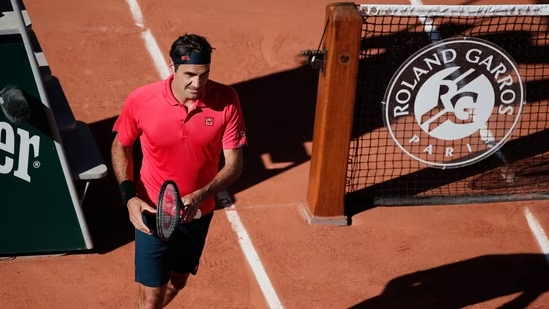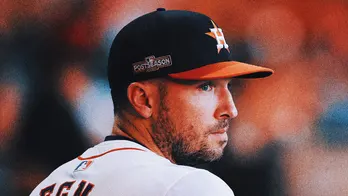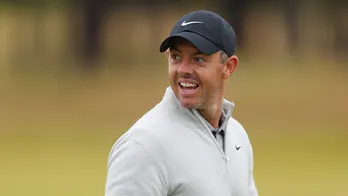The underrated theatre that is Roger Federer on clay
Roger Federer entered Court Philippe Chatrier in a shirt the colour of blood, yet it wasn’t as ominous as the red of the clay he had stepped on to. On the very court and surface that caused his itchiest relationship with the sport, Federer placed his kit bag and walked gingerly towards his opponent, Denis Istomin, to play his first match of any consequence this year.  PREMIUM
PREMIUM
Perhaps because his face and expressions were covered in a black mask, even the broadcast cameras focused on his knees—multiple surgeries on which had kept him out of Grand Slam action since the Australian Open in 2020; this Federer truly resembled a pre-pandemic relic.
To begin the contest against Istomin and his own joints, Federer watched the Uzbek qualifier toss the ball up. Don’t underestimate Istomin's giant-killing abilities either. In 2017, he took out Novak Djokovic at the Australian Open, which Federer went on to win—his first Grand Slam in nearly five years. But seemingly before the ball tossed up by Istomin could even come down, Federer had won the first set. It had taken all of 22 minutes. A smoking service winner clipped the frame of Istomin’s racquet and that was that; Federer swished back his perfectly parted hair and smiled to the sun.
Twenty-two minutes. Despite the fact that before today, Federer had played all of three matches this year. That’s it. What’s worse is that he lost two of them to near nobodies—in 42nd ranked Nikoloz Basilashvili in Doha, and more significantly on the clay of Geneva to No.75 Pablo Andujar. All that made Federer’s three-set victory over Daniel Evans his only win this year, coming into Monday that is. This utter lack of confidence or match fitness could well have made Federer feel like someone had pressed his reboot button. Rebooted, a few months shy of his 40th birthday that too.
It should have been Istomin testing Federer’s movements, but for the entirety of the first set it was the other way around. Like when Istomin was serving at 2-4 down and was dragged ahead on the return by Federer’s short-armed backhand. The Uzbek hunted down the drop and played a cheeky one himself, albeit crosscourt. Federer could’ve chosen to not work those recently repaired legs, but he ran it down with the abandon of a teen and hooked a winner over the highest point of the net—all this on the slide. It made for glorious viewing, as have most of his deep runs on this court in the past.
Federer’s love-hate relationship with the soil is well-documented and makes for a most interesting case study. The greatest grass-court player of all time grew up playing exclusively on clay—at the TC Old Boys in Basel—and was then completely adept with all the requirements of the surface; quite possibly the best player on clay too, until a teenage Spaniard came along in 2005. On four occasions, Rafa Nadal was the proverbial final hurdle to trip him on the second Sunday of various French Opens, but the one that wounded Federer the most was 2008, when he won a total of four games in the most one-sided Slam final of his career (the final set was a bagel).
Just like in the previous set, Istomin found himself multiple break-points down in the first service game of the second set. Unlike in the previous set, Istomin held. It only made the Swiss shake off any remnant shackles and glide seamlessly to all corners of the court. There was an overhead he didn’t put away at 1-1, so he elegantly backtracked with the lob and sky-hooked a winner, one leg folded majestically in the air. Istomin was promptly broken next game, and the second set was soon over too—thanks to yet another ace—with only 57 match minutes having passed overall. Federer’s touch was always imperious but now so were his serves, just like in the year after his lowest ebb in Paris.
Just when no one in their right minds gave him a chance—especially after he had relinquished his Wimbledon crown to Nadal as well in 2008 and then handed his great rival his maiden hard-court Grand Slam in the Australian Open in 2009 with a spirit-crushing five-set loss—
plenty of magical things happened during Federer’s French fortnight in 2009. A day after Nadal’s first-ever loss in Paris (to his blisters as much as to Robin Soderling), Federer turned around a two-set deficit in the fourth round against Tommy Haas. There was another five-setter in the semis against crowd-favourite Juan Martin del Potro. So, in the final, Federer thanked Soderling for his only French Open title to date by slipping to his then good knees and copiously weeping.
That moment never repeated itself for Federer in Roland Garros. Which explains why when he first chose to miss a Grand Slam in 2016—the year he had his first major surgery—he elected to skip the French Open. That broke a most remarkable streak of appearances at the Majors for Federer, stretching back to the previous millennium. A missed Roland Garros (and US Open that year as well) recharged him enough for 2017 to win not one but two Slams, so he skipped the 2017 French Open as well. And then again in 2018, before showing up when he was least expected in 2019. Even more unexpected was his run to the semifinal, where he lost to, who else, but Nadal.
Monday was his first feel of the Parisian mud since that day. It didn’t look that way for the 92 minutes he was on court, where an old man made those old knees dance once again, in possibly his final attempt to befriend that red grime he loves to hate so very much.
Experience unrestricted digital access with HT Premium
Explore amazing offers on HT + Economist Start 14 Days Free Trial Already Subscribed? Sign In
Disclaimer: The copyright of this article belongs to the original author. Reposting this article is solely for the purpose of information dissemination and does not constitute any investment advice. If there is any infringement, please contact us immediately. We will make corrections or deletions as necessary. Thank you.







